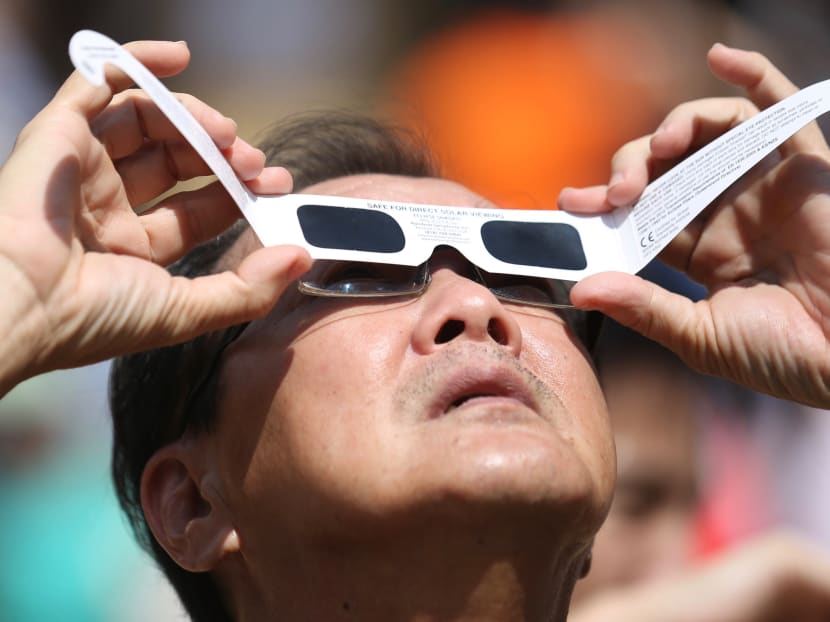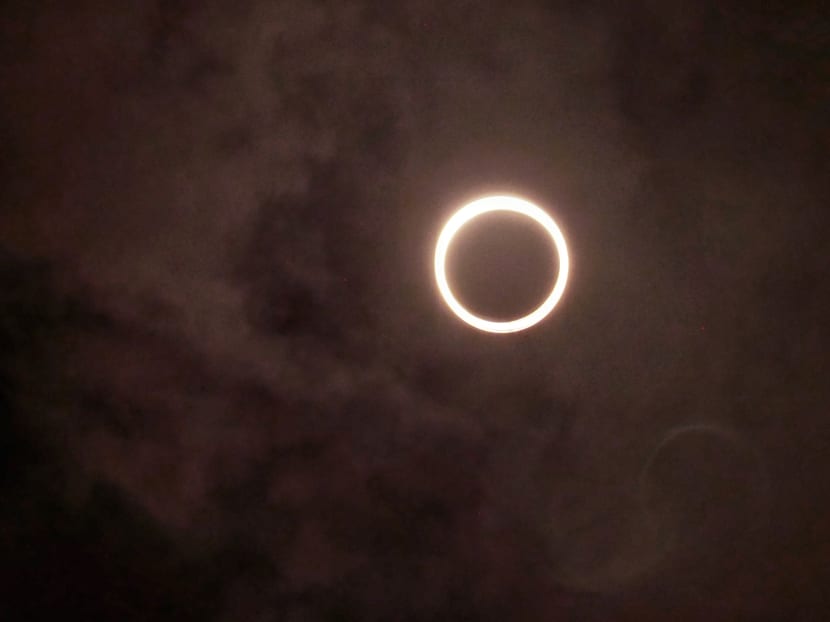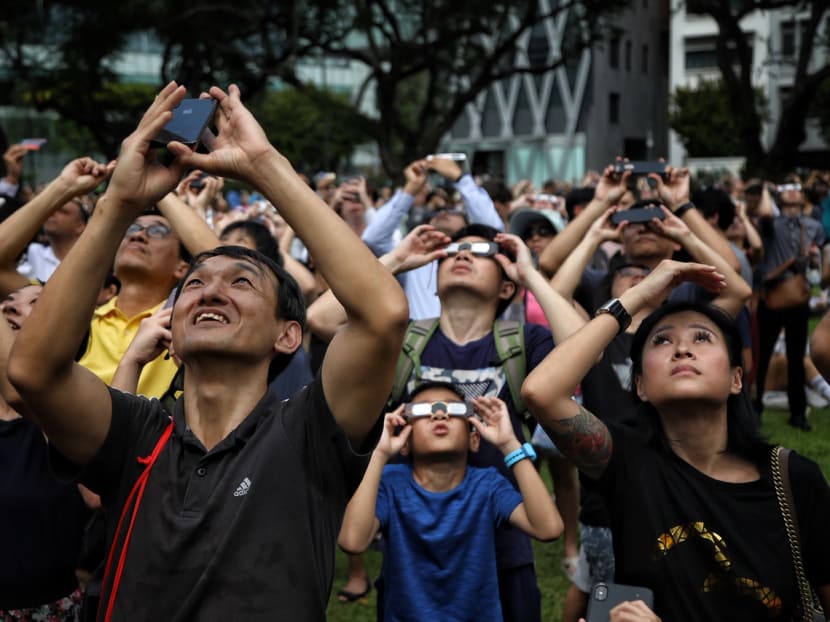S’poreans at viewing sites islandwide crane their necks spellbound as moon blocks sun, leaving ‘ring of fire’
SINGAPORE — Mr Surafian Suhaimi was anxious that his kids should not miss the rare annular solar eclipse that unfolded in Singapore skies on Thursday (Dec 26) as the moon inched towards the sun’s centre, leaving a spectacular “ring of fire”.

A man viewing the annual solar eclipse with protective glasses at Kebun Baru Spring Amphitheatre on Thursday (Dec 26) where more than 1,000 viewers gathered.
SINGAPORE — Mr Surafian Suhaimi was anxious that his kids should not miss the rare annular solar eclipse that unfolded in Singapore skies on Thursday (Dec 26) as the moon inched towards the sun’s centre, leaving a spectacular “ring of fire”.
Like hundreds of others who watched spellbound, Mr Surafian, 42, and his family headed to the Kebun Baru Spring Amphitheatre to catch a glimpse of a celestial event last witnessed here two decades ago. Astronomers say the phenomenon will not be seen in Singapore again until 2063.

The annular solar eclipse seen from Singapore on Thursday (Dec 26), leaving a "ring of fire" as the moon blocked out most of the sun. Photo: Raj Nadarajan/TODAY
Surafian's family travelled from their house in Bedok to the amphitheatre in Ang Mo Kio, in the heartlands, as it was a much more “familiar” setting than the other locations where Singaporeans gathered to crane their necks as the four-hour event unfolded.
“I happened to take leave, so I think it was a good event to bring my kids to see a phenomenon that happens rarely. Once in a lifetime as I suppose,” he told TODAY.
When the moon blocked out most of the sun at 1.23pm, leaving the ‘ring of fire’, the scene was somewhat darker — leaving the watching crowd in a hushed state of awe. Despite somewhat cloudy skies, the phenomenon was clearly visible.
The event organised by the Kebun Baru Heights Residents’ Committee was one of the many locations across the island that offered a clear view of the astronomical wonder. Free solar viewing glasses were handed out given the risk of eye damage if viewing with the naked eye.
At National Junior College, visitors could observe the sun magnified up to 500 times its size using the school’s High Resolution Solar Research Observatory.
And at another heartlands location, in Jurong Lake Gardens, free workshops were set up to allow participants to make their own solar viewer, along with six solar telescopes and a giant set of binoculars on site.
When TODAY visited the Kebun Baru Amphitheatre at 11.30am, visitors were already setting up their photography gear and looking for the best viewing spots. According to organisers, more than 1,000 people showed up there.

Some of the viewers of the annular solar eclipse gathered at Hong Lim Park on Thursday (Dec 26). Photo: Raj Nadarajan/ TODAY
Mr Titan Mok, 21 and Miss Rachel Tan, 19, who are residents at Yishun, made their way down to the event in Ang Mo Kio for a date.
“We actually planned to come here. We looked up for locations to view the solar eclipse. We wanted to go to Bishan-Ang Mo Kio but decided to come here because they actually provided free solar glasses,” Miss Tan said.
WHAT IS AN ANNULAR SOLAR ECLIPSE?
According to the Science Centre’s website, an annular eclipse occurs when the moon covers the sun’s centre, leaving a “ring of fire” created by the sun’s visible outer edges. In turn, the moon casts a shadow on earth.
These events are rare as they take place only when a new moon coincides with a lunar node, a point where the moon’s path crosses the sun’s path. During the eclipse, the sun, new moon and earth are positioned in a straight line.
DIFFERENT WAYS TO LOOK AT THE SOLAR ECLIPSE
As others gazed skywards with solar glasses and phone cameras, Mr Tan Juay Seng, 48, was looking down at some of his do-it-yourself pin-hole projectors to view the solar eclipse.
Mr Tan and his wife made a spontaneous decision to attend the solar eclipse event at the Kebun Baru Amphitheatre, which is in their neighbourhood. They brought down a few pin-hole projectors they made that morning.
“It was very crowded this morning, people lining up to get the glasses. So I thought I would just make one, easier to see. It took me five minutes. I have the box at home and just pasted some aluminium foil over it,” he told TODAY.
He said the pin-hole projector makes a small projection of the eclipsed sun beam onto the box, showing a reverse image of the solar eclipse.
Some students from Nan Chiau High School had made their way from their school in Sengkang to catch the event. Lim Yeo Di, 15, and his friends are photography enthusiasts and took their cameras to school to be sure they would make it in time to the amphitheatre.
Yeo Di told TODAY that they had bought special camera filters to take pictures of the afternoon’s solar eclipse.
“Because when you don’t have a filter, what happens is that there’s a very high tendency of the sun burning the camera. It damages the camera, so we have to use one of those.”
As the last solar eclipse happened before he and his friends were born, he said: “I’m really excited. The last time I took something from the sky was the dark moon so the solar eclipse is the first.”
Prime Minister Lee Hsien Loong also joined in and took pictures of the "spectacular" solar eclipse. Sharing on Facebook a photo which he took at Gardens by the Bay, he said: "The skies were a little cloudy, but fortunately at the critical moment the sun (and moon) peeped through!"









